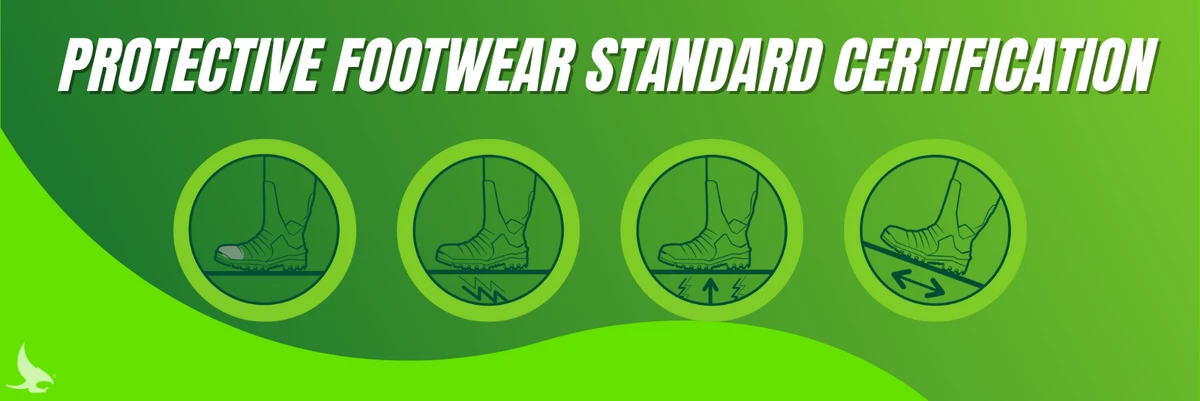OSHA, ASTM F2413-18, ASTM F2892-18 or ASTM F3445-21? These are some of the codes that often appear when you're looking for work shoes or work boots. But what do they mean? Are they important? How can this determine which work shoes are better suited for you?
These are some of the questions that we'll be answering in this blog. We'll also provide you with a list of safety codes and their respective meanings. This way, you'll know if you're buying the right work boots for you.
First, what you need to know is that these codes represent the safety level of the footwear. They ensure the user that the footwear complies with all the requirements to provide the defined safety level.

PPE Regulations (OSHA 1910.132)
In the USA internal market, the regulation that defines the legal obligations of PPE is the OSHA 1910.132. The OSHA (Occupational Safety and Health Administration) is a division of the US Department of Labour. Its duty is to guarantee the employees’ safety in the workplace. To ensure and manage their responsibility, the institution through the establishment and implementation of a series of relevant standards, in this case, the OSHA 1910.132 and 1910.136.
Within this standard, we can find the American Society for Testing and Materials (ASTM International), an independent non-profit organization whom the OSHA incorporate their standards.
OSHA standards address three major aspects of protective footwear:
Performance Requirements: The performance requirements were established by the predecessor to this specification, ANSI Z41. The principal purpose of the ASTM standard is the certification of protective footwear.
Testing Standards: The certification must be carried out by independent third party laboratories in order for the footwear to bear the ASTM mark.
Labelling and Identification: All protective footwear that meet ASTM must be labelled according to its certification, in order to inform the wearer.
Safety level and Performance requirements (ASTM F2413-18 & ASTM F2892-18)
Previous to ASTM performance requirements, it is necessary to identify the safety level of the work shoes (Non-Safety or Safety) with the following standards:
ASTM F2892-18: ‘’Standard Specification for Performance Requirements for Soft Toe Protective Footwear (Non-Safety / Non-Protective Toe)’’.
ASTM F2413-18: ‘’Standard Specification for Performance Requirements for Protective (Safety) Toe Cap Footwear’’.
Following the identification of the safety level, performance requirements can be implemented by the ASTM F2412-18a (Testing method standard for foot protection):
Impact (I) – Impact resistance for the toe area of the footwear. This standard covers falling objects of varying weights and heights, which may be dropped onto the foot.
Compression (C) - Compression resistance for the toe area of footwear. This standard covers a slower crushing load, such as a vehicle running over the foot.
Metatarsal (Mt) -This standard covers protection of the upper, or metatarsal, region of the foot.
Conductive (Cd) - This standard covers the shoe’s ability to resist the build-up of static charge, which can be dangerous in areas that may contain explosive chemicals.
Electrical Hazard (EH) - This standard covers the shoe’s ability to protect the wearer from electrical shocks.
Static Dissipative (SD) - This standard rates the shoe’s ability to safely conduct any buildup of static electricity through the sole and into the floor.
Puncture/Penetration Resistant (PR) - This standard covers the shoe’s ability to protect the wearer from sharp objects puncturing the sole of the shoe, such as nails, glass, etc.
Slip Resistance (ASTM F3445-21)
Back in 2021, The ASTM International took an important step by publishing the ASTM F3445-21 ‘’Standard Specification for Performance Requirements when Evaluating Slip Resistance of Protective (Safety) Footwear using ASTM F2913 Whole Shoe Test Method’’.
Slip Resistance (SR) – This standard covers the shoe sole’s ability to protect the wearer from slips and falls due to greasy or wet floors.
Supplemental Non-Covered Standards
Since not all hazards that employees may face are covered by OSHA requirements, employers must also consider additional protective properties, for example:
Ankle Protection – When ankle sprain is likely to happen in the work environment; walking on an uneven surface, riding a motorcycle…
Chemical Permeability – When the employee is exposed to any chemical, the employer must provide footwear impermeable, in order to avoid contact between the two elements.
Biological Agents – When the work environment and the employee are subject to biological agents, the footwear should be impermeable to this and also easy to get disinfected.
How to label safety footwear that meets ASTM?
The ASTM also requires that every footwear certified by their standards must have the ASTM certification labelled on the shoe. It can be shown outside or inside the work boots, on the tongue of the work shoes. It can also be stitched or stamped. For example:

The ASTM F2413-18 must be on the top of the rectangle (safety).
The M stands for Male. Male or Female should also be identified on the label.
The I stands for Impact.
The C stands for compression.
The SD 35 Static Dissipative
Outside the rectangle, we can see the Slip resistance norm.
